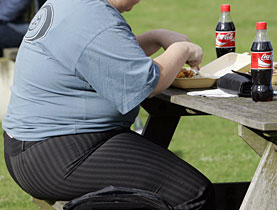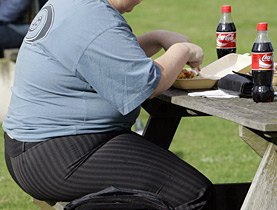Study raises question marks over obesity rates

Obesity rates in Switzerland may be considerably underestimated, particularly among elderly women, new research findings suggest.
A study comparing Body Mass Index (BMI) and waist circumference measurements among the Lausanne population recently found large discrepancies in obesity calculations.
BMI is worked out by dividing your weight in kilograms by your height in metres squared. A BMI of 25 to 29.9 is considered overweight and one 30 or above is deemed obese. Women and men are said to be obese with waist measurements of 88cm and 102cm, respectively.
The study, carried out among 6,000 men and women aged 35 to 75, and published in the BMC Public Health online journal in September, found that when calculating BMI, on average 17 per cent of men and 14 per cent of women in Lausanne were obese.
These figures rose to 24 per cent among men and 31 per cent for women when applying the waist circumference, or abdominal obesity, measurement, said by some experts to be a much more accurate measure of future health risk than BMI alone.
The results were even worse as people got older: 17.3 per cent of women aged 65-75 and 22.7 per cent of men were obese using BMI, compared with 45.3 per cent of women and 39.9 per cent of men using the waist circumference measure.
Obesity has been steadily increasing in Switzerland over the past 30 years. Based on a 2007 telephone poll, the Federal Health Office says that 30 per cent of the Swiss population are overweight and seven per cent obese.
A recent article in Swiss Medical Weekly journal said based on BMI calculations obesity ranges between 14.2 –8.9 per cent for men and 12.5-7.9 per cent for women, depending on whether data was measured or self-reported.
“Not good news”
Pedro Marques-Vidal, an obesity specialist at the Lausanne University Institute of Social and Preventive Medicine, said overall his study findings were not very good news.
“The obesity results based on BMI are of concern, as obesity is quite common after 55 and even worse when you retire, but it might prove to be even worse if you look at how fat is distributed on people’s bellies,” he told swissinfo.
“We were a little puzzled when we saw the results as we were not expecting such a high prevalence of abdominal obesity among the Swiss, but this might be due to the cut-off measures for abdominal obesity.”
Heinrich von Grünigen, president of the Swiss Obesity Foundation, said he was not that surprised by the results, which “confirm what has been reported by doctors and suspected”.
“The BMI is a contested indicator,” he said.
While admitting that the waist circumference measure, or even the waist-to-hip ratio, was generally a more accurate indicator of obesity, the Federal Health Office said differing BMI methodologies and Lausanne’s small study sample meant that the study could not be extrapolated and compared with its 2007 survey.
Obese elderly
Yet the Lausanne study raises worrying questions about obesity among the elderly.
Like in the US, the obese elderly are becoming much more commonplace in Switzerland, said Marques-Vidal.
“Currently there is no data on the elderly,” he said. “The reference study, known as the Monica survey conducted 20 years ago, stopped at 64. There was no clear prevalence of abdominal obesity in elderly Swiss.”
A wave of obesity among the elderly is coming, confirmed von Grünigen.
“Some old people’s homes told us that their residents are getting fatter and they have to change things like stools, chairs and toilets for patients over 150kg,” he said.
Marques-Vidal said it was very difficult to explain such high obesity rates among the Swiss elderly, but it was probably down to “an increasingly sedentary lifestyle not fully compensated by a decrease in dietary intake”.
Von Grünigen agreed: “When you get older your body uses less energy. It’s proven that men and women over 45 tend to grow one kilogram heavier a year if they don’t do any exercise or reduce their food intake.”
Contested measure
Although emerging research suggests that BMI is no longer the best predictor of future health problems, Marques-Vidal doesn’t believe BMI will disappear that quickly.
Waist measurements are not that simple and a standard methodology is still lacking. Up until recently, five different measurement points were used.
And the scientific community has still not reached consensus on which waist measurement refers to obesity, he said.
The debate is still ongoing, particularly among people in Asia, said Marques-Vidal.
As long as these questions are not sorted out, the Lausanne-based doctor recommends that people concerned about their weight continue to calculate using BMI.
swissinfo, Simon Bradley
The World Health Organization (WHO) classifies around 400 million people around the world as obese, 20 million of them children under the age of five.
In the EU, up to 27% of men and 38% of women are now considered obese.
Experts say obesity is most frequent among people with lower incomes and less education, who tend to eat more meat, fat and sugar.
Being overweight or obese increases a person’s chances of contracting a condition such as diabetes, heart disease, hypertension, cancer and osteoporosis.
Obesity costs anything between two and eight per cent of a nation’s health budget, according to the WHO.
Switzerland’s fifth national report on nutrition published in 2005 says that 37% of the Swiss population are overweight.
A recent Swiss medical report said BMI obesity figures range between 14.2 –8.9% for men and 12.5-7.9% for women, depending on whether data was measured or self-reported.
Nearly one in five youngsters, aged 15 to 25, eats fast food at least twice a week.
Diseases and health problems related to weight cost SF2.7 billion every year in Switzerland.
The number of obese children has increased five-fold since 1980.

In compliance with the JTI standards
More: SWI swissinfo.ch certified by the Journalism Trust Initiative




You can find an overview of ongoing debates with our journalists here. Please join us!
If you want to start a conversation about a topic raised in this article or want to report factual errors, email us at english@swissinfo.ch.